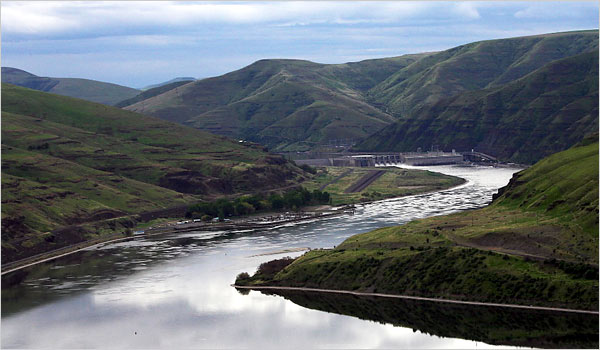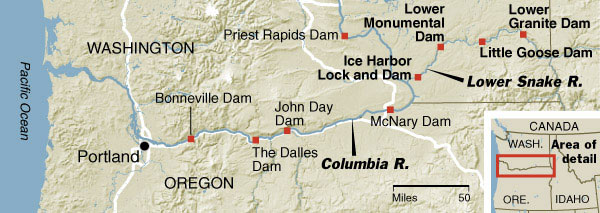forum
library
tutorial
contact

On the Snake River, Dam's Natural Allies
Seem to Have a Change of Heart
by Felicity Barringer
New York Times, May 13, 2007
|
the film forum library tutorial contact |

|
On the Snake River, Dam's Natural Allies
by Felicity Barringer
|
 LOWER GRANITE DAM, Wash. - The wheat Bryan Jones grows in Eastern Washington begins its journey to Asia on barges along the lower Snake River. The river, once a wild, muscular torrent, was made barge friendly a quarter-century ago by four of the nation's most controversial hydropower dams.
LOWER GRANITE DAM, Wash. - The wheat Bryan Jones grows in Eastern Washington begins its journey to Asia on barges along the lower Snake River. The river, once a wild, muscular torrent, was made barge friendly a quarter-century ago by four of the nation's most controversial hydropower dams.
A tame river keeps Mr. Jones's business viable. So why is he is spending time with the guides and fishermen who want to remove the dams? In part, because he feels the tug of environmentalist arguments that the dams will endanger wild salmon that, even more than wheat, are the region's natural bounty.
"I always believed dams were economically too big of a hurdle to attack," said Mr. Jones, who is 52. "But I began to realize that we are potentially losing runs of salmon" along this tributary of the Columbia River.
It is still a relatively rare phenomenon, but one becoming more noticeable: some members of the dams' natural constituency, like farmers, are talking to their downriver antagonists about a future that might not include the four lower Snake River dams. There is talk of reconstituting a regional rail system to deliver Mr. Jones's wheat to Portland, Ore. There is talk of a wind farm to replace the electricity - enough to power most of Manhattan - generated by the four dams.
The conversations are still in their early stages, and political support for the dams remains strong. Congressional ties to the Bonneville Power Administration, which provides electricity from the dams to regional utilities and businesses, are many, and few politicians want to back an action that could raise electricity bills and cost jobs. At best, wind power is intermittent and expensive; in 2005, regional electricity costs were more than 25 percent less than the national average.
But the pressures on the hydrosystem's traditional operations are accumulating, and conversions like Mr. Jones's have taken on an enhanced significance. As former Gov. John A. Kitzhaber of Oregon said in an interview, "by not talking to each other, not trying to figure out the real economic issues, we're setting up a situation where someone else is going to figure out our future for us."
His allusion was clear: he fears that the operations of the Columbia River dams could be determined by a federal judge if federal and local agencies here cannot come up with a plan to successfully protect salmon.
Indeed, Judge James A. Redden of the Federal District Court in Portland, who has presided over the central Endangered Species Act challenge to dam operations and whom the Vancouver Columbian called "the best friend of endangered fish in the Northwest," has been acerbic in his dismissal of the most recent Bush Administration plan. Among other things, the administration argued that the Columbia River dams could not be removed because they were an immutable part of the landscape, having been built before the Endangered Species Act went into effect. It suggested habitat restoration would save the fish population.
The Bush administration appealed Judge Redden's 2005 ruling, and last month the Ninth Circuit Court of Appeals, in San Francisco, forcefully backed him. Under the federal government's theory, the appeals court held, "a listed species could be gradually destroyed, so long as each step on the path to destruction is sufficiently modest. This type of slow slide into oblivion is one of the very ills the Endangered Species Act seeks to prevent."
On the lower Snake River, four runs of wild fish are threatened and one of these, sockeye salmon, may be irretrievable. Of the others, the spring and summer Chinook salmon, which have been going upriver for the past few weeks, are of most concern.
A new fish-protection plan, called a biological opinion, is due from the National Oceanic and Atmospheric Administration later this year. Judge Redden has warned that if it fails to meet his viability test, he may have to take drastic action - presumably, taking the running of the Columbia River hydropower system into his own hands, as another federal judge, W. Arthur Garrity, did in the 1970s with Boston's schools after the local community could not find a way to desegregate.
The Bonneville Power Administration, also known as the B.P.A., is not a named defendant in the endangered-species lawsuit, but because the dams' operators at the Army Corps of Engineers work closely with Bonneville's engineers, B.P.A. officials are often called on by the courts to help explain corps actions.
 The Bonneville administrator, Stephen J. Wright, said in an interview in his Portland office that the potential loss of 5 percent of the electricity generated regionally each year would "magnify substantially" the current challenge of feeding the region's growing hunger for power without raising costs.
The Bonneville administrator, Stephen J. Wright, said in an interview in his Portland office that the potential loss of 5 percent of the electricity generated regionally each year would "magnify substantially" the current challenge of feeding the region's growing hunger for power without raising costs.
Mr. Wright and Bob Lohn, who heads the regional office of the National Marine Fisheries Service, argue that dams are hardly the only environmental disturbance harming the salmon runs, and that the bumper salmon year of 2001 demonstrates that salmon and dams can coexist. Judge Redden has deemed their plans for accomplishing the goal of salmon recovery inadequate. Environmentalists say their optimism about coexistence is belied by the steady decline in fish runs.
Out here at the Lower Granite Dam, Witt Anderson, the chief of the Columbia River fish management office at the Army Corps of Engineers, said, "We're mining the last few improvements we can get out of the hydrosystem."
But Mr. Anderson argues that dam removal alone would not be a quick fix to what ails the fish. Given the impact of factors including agricultural runoff, culverts, cyclical changes in ocean temperature and the amount and location of ocean-borne food available to salmon, "We would say the solution is a comprehensive plan that addresses the life-cycle of fish, gravel to gravel."
Smaller private dams have been breached around the country, and there are plans to do so at dams on the Elwha and White Salmon Rivers in Washington. The idea of breaching the Klamath River dams in Oregon and California is getting new and serious scrutiny. But the Lower Snake River dams are significantly bigger, in economic terms, than any of these.
There is, first of all, the electricity they generate. And the transportation. And the creation of inland ports, like Lewiston. Given these significant economic interests, the rethinking being done by a farmer like Brian Jones or a Lewiston city councilman like Jim Klauss is startling.
"When they created these dams in the 60s and 70s they said we'd have a lot of economic development," a promise that never materialized, said Mr. Klauss, who is 47. Now the sediment trapped behind the Lower Granite dam requires constant dredging just to make a small passage for boats and the levees may need to rise higher to keep the city safe in storms.
So, although the City Council is pro-dam, Mr. Klauss said he was dubious.
"We're kind of on a yo-yo," he said. "We built these dams and changed everyone's lifestyle, and we can't say we have a lot to show for it. If you take them out you yo-yo back and change everyone's lives again." But, he said, it may be worth it.
To the north, in Spokane, Wash., the president of the local chapter of Trout Unlimited sees these small cracks in the dams' natural constituencies as the beginning of a bigger political shift. "This new generation," said Harvey Morrison, who is 64, "has been willing to ask the hard questions."
learn more on topics covered in the film
see the video
read the script
learn the songs
discussion forum
